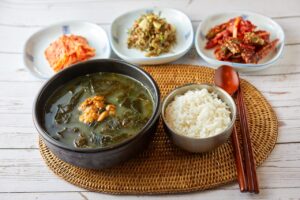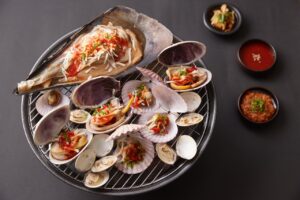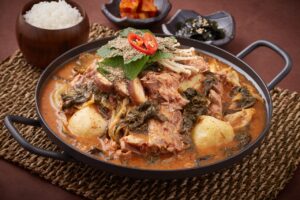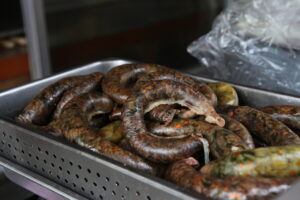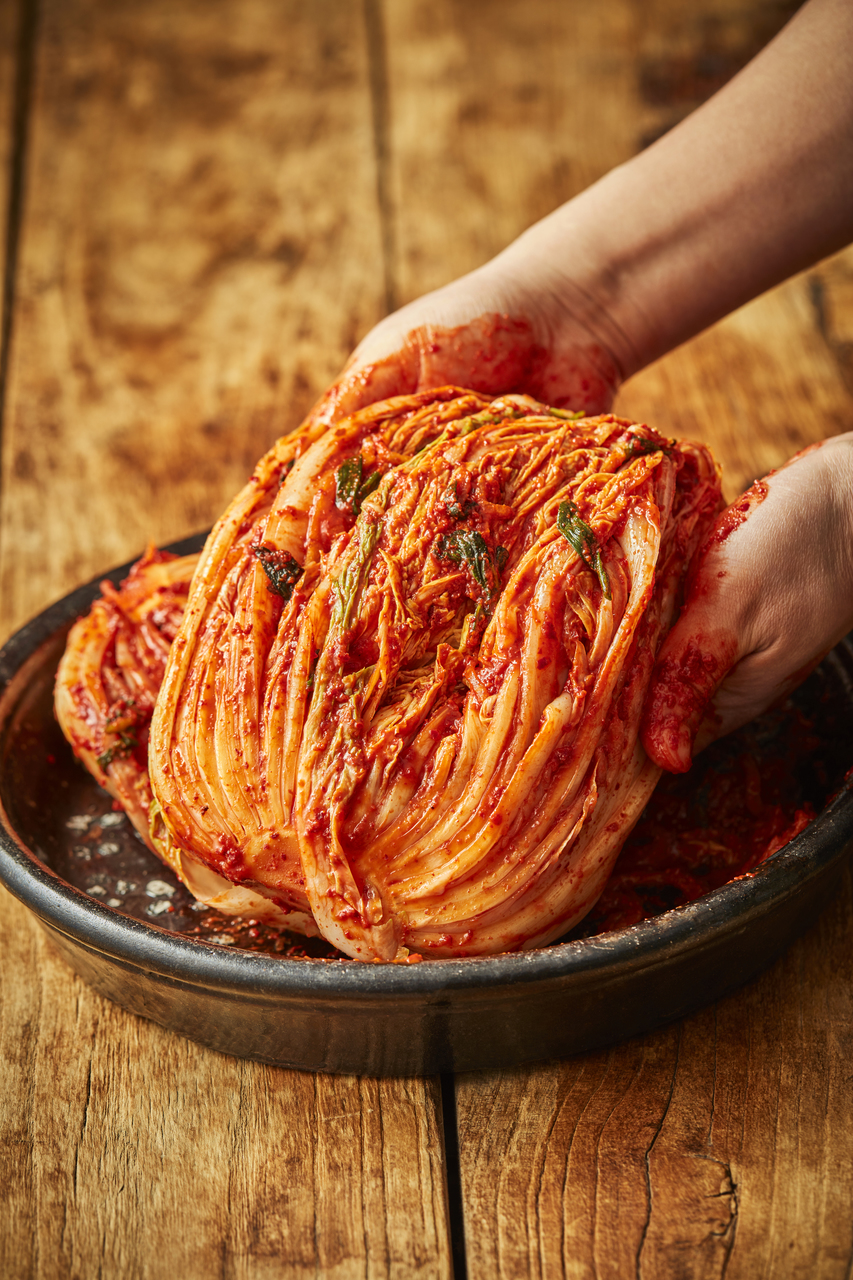
Kimjang ⓒ한국관광공사 사진갤러리-알렉스 분도
What is Kimchi?
Kimchi is a traditional Korean side dish made from fermented vegetables, with napa cabbage and Korean radishes being the most common choices. It is known for its spicy, sour, and umami flavors. Kimchi is a staple in Korean cuisine and is also popular in other parts of Asia.
The basic process of making it involves salting and then fermenting vegetables. Here’s a general overview of how it’s made:
- Prepare the Vegetables: The primary vegetable used in kimchi is napa cabbage or Korean radishes. These vegetables are usually cut into pieces and then soaked in a saltwater brine. This step helps to soften the vegetables and draw out excess water.
- Make the Paste: The key to kimchi’s unique flavor is the spicy and flavorful paste that’s made from ingredients like gochugaru (Korean red pepper flakes), garlic, ginger, fish sauce, salted shrimp, and sometimes sugar. The combination of these ingredients creates a fiery and pungent sauce.
- Mix Vegetables and Paste: After the vegetables have been soaked and rinsed, they are mixed with the gochugaru paste. The paste is often spread between the leaves or mixed thoroughly with the vegetables, ensuring even distribution of flavors.
- Fermentation: Once the kimchi is prepared, it’s placed in a container or jar and left to ferment at room temperature for a period that can vary from a few days to several weeks, depending on the desired level of fermentation. The container may be sealed or lightly covered, allowing gases produced during fermentation to escape.
- Storage: After the desired fermentation time has passed, it can be refrigerated, which slows down the fermentation process. Properly stored it can last for months or even longer.
It comes in many variations. In addition to the traditional napa cabbage or radish one, there are hundreds of regional and seasonal variations that incorporate different vegetables, seasonings, and levels of spiciness. It is not only a delicious side dish but is also considered a healthy food, as it’s packed with vitamins, probiotics, and other nutrients that can contribute to gut health.
Kimchi is a fundamental part of Korean culture and cuisine, and it’s often served with rice and used as an ingredient in various Korean dishes, including kimchi fried rice, kimchi stew (kimchi jjigae), and kimchi pancakes (kimchijeon). Its bold and complex flavors make it a unique and beloved culinary tradition.
History
It has a long and storied history in Korean cuisine, dating back thousands of years. It is a traditional fermented dish made primarily from vegetables, with napa cabbage and Korean radishes being the most common choices. The preparation and consumption of it are deeply ingrained in Korean culture. Here is a brief overview of the history :
- Ancient Origins: The origins of them can be traced back over two thousand years to the Three Kingdoms period in ancient Korea (57 BC – 668 AD). During this time, vegetables were preserved through a process of salting and fermentation to ensure a stable food supply during harsh winters.
- Introduction of Red Pepper: Red pepper, a key ingredient in modern kimchi that gives it its distinctive spicy flavor, was introduced to Korea in the late 16th century through trade with the Americas. Prior to that, kimchi was typically not spicy.
- Fermentation Techniques: Over the centuries, Koreans developed various fermentation techniques and recipes for it, with different regions and seasons leading to a wide variety of kimchi styles and flavors. Lactic acid fermentation played a central role in this preservation method.
- Cultural and Symbolic Significance: It has deep cultural significance in Korea. It was not just a staple food but also a symbol of Korean identity and an important offering in ancestral rituals. Its red color and connection to preservation were seen as symbols of vitality and longevity.
- Modernization and Commercial Production: In the 20th century, with the modernization of South Korea, kimchi production began to be industrialized, leading to the commercialization of kimchi products. Refrigeration also enabled year-round availability of fresh vegetables, reducing the reliance on kimchi for winter food preservation.
- Global Popularity: In recent decades, Korean cuisine, including kimchi, has gained international popularity. Kimchi is not only consumed in Korea but also widely appreciated in many parts of the world, thanks to its unique flavor and health benefits.
- UNESCO Recognition: In 2013, kimchi and kimjang (the traditional process of making kimchi) were inscribed on UNESCO’s Representative List of the Intangible Cultural Heritage of Humanity. This recognition acknowledges the cultural and social significance of kimchi and kimjang in Korean society.
It’s history is a testament to the resourcefulness and ingenuity of the Korean people in preserving vegetables for the long and harsh Korean winters. Today, it is not only a traditional food but also a beloved and iconic part of Korean culinary heritage, enjoyed by people worldwide.

What is Kimjang?
Kimjang is a significant cultural event in Korea that involves the preparation and preservation of kimchi for the winter season. The word “Kimjang” (김장) consists of two Korean characters: “kim” (김) means “salted,” and “jang” (장) means “sauce” or “paste.” Kimjang can be roughly translated to “making kimchi.”
Kimjang typically takes place in late autumn, usually in November or early December, in anticipation of the harsh winter months when fresh vegetables are scarce. It is not just about making it but a communal and family tradition that has deep cultural and social significance in Korea.
Here are some key aspects of Kimjang:
- Community and Family: Kimjang is a communal activity that often involves extended families, neighbors, and friends. It’s an opportunity for people to come together, strengthen bonds, and share in the labor-intensive process of making large quantities of them.
- Preservation for Winter: The primary goal of Kimjang is to prepare and preserve a sufficient amount of them to sustain a family through the winter months when fresh vegetables are scarce. This ensures that there is a stable supply of nutritious and vitamin-rich food during the cold season.
- Traditional Methods: Many families adhere to traditional kimchi-making methods during Kimjang, which may involve preparing and fermenting large quantities of them. This can include using napa cabbage, Korean radishes, and various seasonings to create diverse kimchi varieties.
- Sharing and Gifting: Kimjang is often an occasion for sharing it with neighbors and relatives, as well as for preparing gift sets. These are not only practical gifts but also a gesture of goodwill and care.
- Cultural Significance: Kimjang is an important cultural tradition in Korea and is recognized as an Intangible Cultural Heritage by UNESCO. It reflects the value of community, preparation for harsh seasons, and the importance of traditional food preservation techniques.
- Modern Kimjang: While the tradition of Kimjang remains strong in Korea, it has evolved with modern times. Many families now buy ready-made one, but the communal and sharing aspects of Kimjang persist.
Kimjang is a time-honored practice that emphasizes the importance of community, tradition, and self-sufficiency, as well as the cultural significance of kimchi in Korean society. It remains a cherished tradition in Korean culture and serves as a reminder of the importance of sharing and preparation for the future.
Exhibition, Experience Kimjang in Korea
…
…
…
Recommend to Read >>> Naengmyeon, Chilled Delight: Exploring the Cool Delicacy of it Aug 2023.

